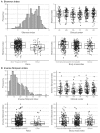Association of dietary patterns with the gut microbiota in older, community-dwelling men
- PMID: 31504105
- PMCID: PMC6766444
- DOI: 10.1093/ajcn/nqz174
Association of dietary patterns with the gut microbiota in older, community-dwelling men
Abstract
Background: While the gut microbiota is relatively stable through adulthood, its composition is influenced by various host and environmental factors, including changes in health, gastrointestinal processes (e.g., transit time, gastric acidity), medication use, and diet. The association of habitual diet, in the form of a posteriori-derived dietary patterns, and microbiota composition has not been adequately studied, particularly in older men.
Objective: The objective was to investigate the association of dietary patterns with the composition and diversity of the gut bacterial microbiota in community-dwelling, older men.
Methods: This cross-sectional study included 517 men who were participants in the Osteoporotic Fractures in Men (MrOS) Study (≥65 y of age at baseline in 2000-2002) and who provided a stool sample and completed an FFQ at MrOS Visit 4 in 2014-2016. Dietary patterns were derived by factor analysis. 16S ribosomal RNA target gene sequencing was performed and taxonomy assignments were derived using the Greengenes database. Linear regression and permutational multivariate analysis of variance (PERMANOVA) considered variations in alpha and beta diversity by dietary pattern, and a model that implements a 0-inflated Gaussian distribution of mean group abundance for each taxa (metagenomeSeq) assessed taxonomic variations by dietary pattern.
Results: In multivariable-adjusted models, greater adherence to the Western pattern was positively associated with families Mogibacteriaceae and Veillonellaceae and genera Alistipes, Anaerotruncus, CC-115, Collinsella, Coprobacillus, Desulfovibrio, Dorea, Eubacterium, and Ruminococcus, while greater adherence to the prudent pattern was positively associated with order Streptophyta, family Victivallaceae, and genera Cetobacterium, Clostridium, Faecalibacterium, Lachnospira, Paraprevotella, and Veillonella. The relative abundance of the dominant gut bacterial phyla, Bacteroidetes and Firmicutes, did not differ between participants with greater adherence to the Western pattern, compared with those with greater adherence to the prudent pattern. Dietary patterns were not associated with measures of alpha diversity, but beta diversity measures were significantly associated with both Western and prudent patterns.
Conclusions: We observed significant associations between dietary patterns and measures of gut microbial composition in this sample of community-dwelling, older men.
Keywords: 16S rRNA gene sequencing; Greengenes database; Osteoporotic Fractures in Men Study; alpha diversity; beta diversity; dietary patterns; food-frequency questionnaire; microbiota; older adults.
Copyright © American Society for Nutrition 2019.
Figures



Similar articles
-
Relation Between Dietary Protein Intake and Gut Microbiome Composition in Community-Dwelling Older Men: Findings from the Osteoporotic Fractures in Men Study (MrOS).J Nutr. 2023 Jan 14;152(12):2877-2887. doi: 10.1093/jn/nxac231. J Nutr. 2023. PMID: 36205552 Free PMC article.
-
The Association between Objectively Measured Physical Activity and the Gut Microbiome among Older Community Dwelling Men.J Nutr Health Aging. 2019;23(6):538-546. doi: 10.1007/s12603-019-1194-x. J Nutr Health Aging. 2019. PMID: 31233075 Free PMC article.
-
Associations between Diet, the Gut Microbiome, and Short-Chain Fatty Acid Production among Older Caribbean Latino Adults.J Acad Nutr Diet. 2020 Dec;120(12):2047-2060.e6. doi: 10.1016/j.jand.2020.04.018. Epub 2020 Aug 12. J Acad Nutr Diet. 2020. PMID: 32798072
-
Gallstone Disease, Obesity and the Firmicutes/Bacteroidetes Ratio as a Possible Biomarker of Gut Dysbiosis.J Pers Med. 2020 Dec 25;11(1):13. doi: 10.3390/jpm11010013. J Pers Med. 2020. PMID: 33375615 Free PMC article. Review.
-
Adherence to the Mediterranean diet can beneficially affect the gut microbiota composition: a systematic review.BMC Med Genomics. 2024 Apr 17;17(1):91. doi: 10.1186/s12920-024-01861-3. BMC Med Genomics. 2024. PMID: 38632620 Free PMC article.
Cited by
-
Gastrointestinal symptoms associated with COVID-19: impact on the gut microbiome.Transl Res. 2020 Dec;226:57-69. doi: 10.1016/j.trsl.2020.08.004. Epub 2020 Aug 20. Transl Res. 2020. PMID: 32827705 Free PMC article. Review.
-
Iron Reshapes the Gut Microbiome and Host Metabolism.J Lipid Atheroscler. 2021 May;10(2):160-183. doi: 10.12997/jla.2021.10.2.160. Epub 2021 Mar 10. J Lipid Atheroscler. 2021. PMID: 34095010 Free PMC article. Review.
-
Gut microbiome variation modulates the effects of dietary fiber on host metabolism.Microbiome. 2021 May 20;9(1):117. doi: 10.1186/s40168-021-01061-6. Microbiome. 2021. PMID: 34016169 Free PMC article.
-
Characteristic gut microbiota and metabolic changes in patients with pulmonary tuberculosis.Microb Biotechnol. 2022 Jan;15(1):262-275. doi: 10.1111/1751-7915.13761. Epub 2021 Feb 18. Microb Biotechnol. 2022. PMID: 33599402 Free PMC article.
-
Effect of the Interaction between Dietary Patterns and the Gastric Microbiome on the Risk of Gastric Cancer.Nutrients. 2021 Aug 3;13(8):2692. doi: 10.3390/nu13082692. Nutrients. 2021. PMID: 34444852 Free PMC article.
References
-
- Chen X, Devaraj S.. Gut microbiome in obesity, metabolic syndrome, and diabetes. Curr Diab Rep. 2018;18:129. - PubMed

